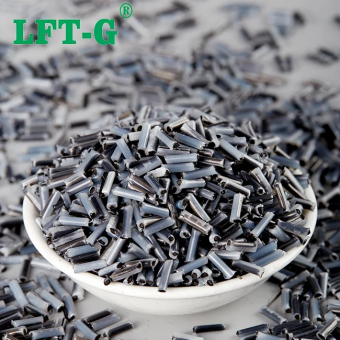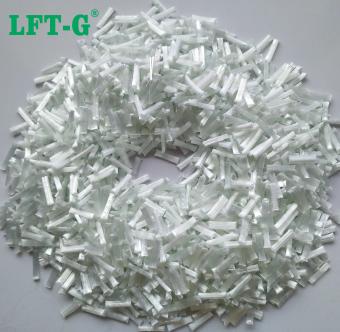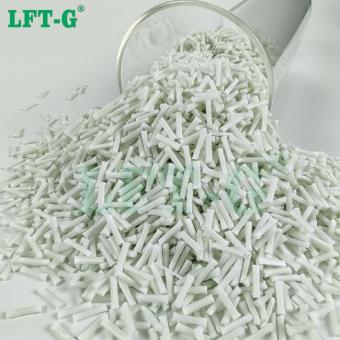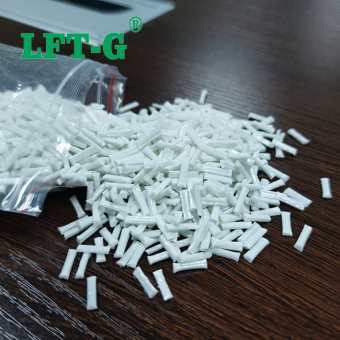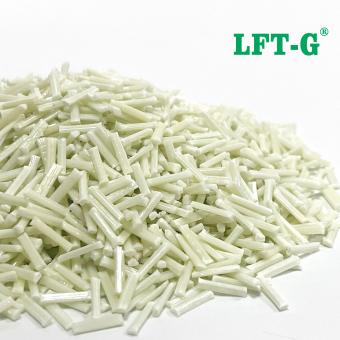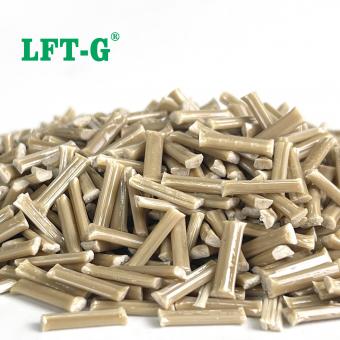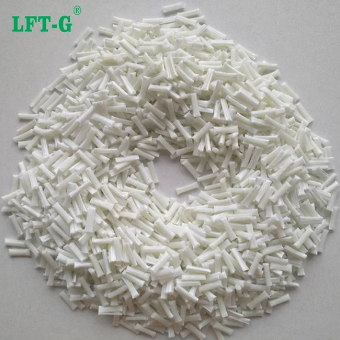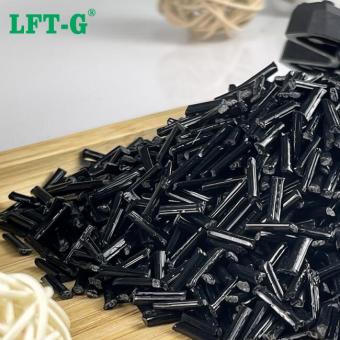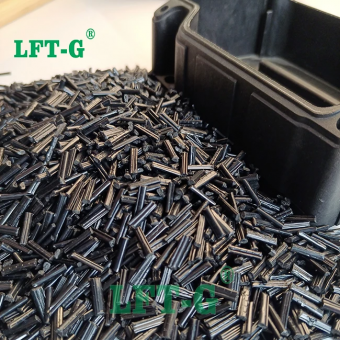-
LFT-G HDPE raw materials filling LGF 30%-60% high toughness compunds pellets 12mm length sample freeHDPE High density polyethylene (HDPE), a granular product. Non-toxic, odorless, crystallinity of 80% ~ 90%, softening point of 125 ~ 135 ℃, the use of temperature up to 100 ℃; hardness, tensile strength and creep is better than low-density polyethylene; wear resistance, electrical insulation, toughness and cold resistance is better; good chemical stability, at room temperature, insoluble in any organic solvents, resistant to corrosion of acids, alkalis and various salts. Long glass fiber Glass fiber reinforced plastic is based on the original pure plastic, adding glass fibers and other additives, so as to improve the scope of use of the material. Generally speaking, most of the glass fiber reinforced materials are used in the structural parts of the products, which is a kind of structural engineering materials, such as: PP, ABS, PA66, PA6, HDPE, PPA, TPU, PEEK, PBT, PPS and so on. Advantages After glass fiber reinforcement, glass fiber is a high temperature resistant material, therefore, the heat-resistant temperature of reinforced plastics is much higher than before without glass fiber, especially nylon plastics. After the glass fiber reinforcement, due to the addition of glass fiber, the plastic polymer chain is restricted to move with each other, therefore, the shrinkage of reinforced plastics decreases a lot, and the rigidity is greatly improved. After glass fiber reinforced, the reinforced plastic will not stress cracking, at the same time, the impact resistance of the plastic improves a lot. After the glass fiber reinforcement, the glass fiber is a high strength material, which also greatly improves the strength of the plastic, such as: tensile strength, compression strength, bending strength, improve a lot. After glass fiber reinforcement, due to the addition of glass fiber and other additives, the combustion performance of the reinforced plastics decreases a lot, most of the materials can not be ignited, it is a kind of flame-retardant material. Datasheet Contact us
- HDPE filling long glass fiber white color
- high performance hdpe with lgf
- injection molded plastic hdpe virgin
- Original color 10-12mm hdpe pellets polymer resin
- engineering plastic can be recycled hdpe
- thermoplastic compounds hdpe high rigidity
Tags :
-
LFT-G industry use HDPE filling LGF 30%-60% high toughness pellets 12mm sample freeHDPE High density polyethylene (HDPE), a granular product. Non-toxic, odorless, crystallinity of 80% ~ 90%, softening point of 125 ~ 135 ℃, the use of temperature up to 100 ℃; hardness, tensile strength and creep is better than low-density polyethylene; wear resistance, electrical insulation, toughness and cold resistance is better; good chemical stability, at room temperature, insoluble in any organic solvents, resistant to corrosion of acids, alkalis and various salts. Long glass fiber Glass fiber reinforced plastic is based on the original pure plastic, adding glass fibers and other additives, so as to improve the scope of use of the material. Generally speaking, most of the glass fiber reinforced materials are used in the structural parts of the products, which is a kind of structural engineering materials, such as: PP, ABS, PA66, PA6, HDPE, PPA, TPU, PEEK, PBT, PPS and so on. Advantages After glass fiber reinforcement, glass fiber is a high temperature resistant material, therefore, the heat-resistant temperature of reinforced plastics is much higher than before without glass fiber, especially nylon plastics. After the glass fiber reinforcement, due to the addition of glass fiber, the plastic polymer chain is restricted to move with each other, therefore, the shrinkage of reinforced plastics decreases a lot, and the rigidity is greatly improved. After glass fiber reinforced, the reinforced plastic will not stress cracking, at the same time, the impact resistance of the plastic improves a lot. After the glass fiber reinforcement, the glass fiber is a high strength material, which also greatly improves the strength of the plastic, such as: tensile strength, compression strength, bending strength, improve a lot. After glass fiber reinforcement, due to the addition of glass fiber and other additives, the combustion performance of the reinforced plastics decreases a lot, most of the materials can not be ignited, it is a kind of flame-retardant material. Datasheet Contact usview more
-
LFT-G industry use HDPE filling LGF 30%-60% high toughness pellets 12mm sample freeHDPE High density polyethylene (HDPE), a granular product. Non-toxic, odorless, crystallinity of 80% ~ 90%, softening point of 125 ~ 135 ℃, the use of temperature up to 100 ℃; hardness, tensile strength and creep is better than low-density polyethylene; wear resistance, electrical insulation, toughness and cold resistance is better; good chemical stability, at room temperature, insoluble in any organic solvents, resistant to corrosion of acids, alkalis and various salts. Long glass fiber Glass fiber reinforced plastic is based on the original pure plastic, adding glass fibers and other additives, so as to improve the scope of use of the material. Generally speaking, most of the glass fiber reinforced materials are used in the structural parts of the products, which is a kind of structural engineering materials, such as: PP, ABS, PA66, PA6, HDPE, PPA, TPU, PEEK, PBT, PPS and so on. Advantages After glass fiber reinforcement, glass fiber is a high temperature resistant material, therefore, the heat-resistant temperature of reinforced plastics is much higher than before without glass fiber, especially nylon plastics. After the glass fiber reinforcement, due to the addition of glass fiber, the plastic polymer chain is restricted to move with each other, therefore, the shrinkage of reinforced plastics decreases a lot, and the rigidity is greatly improved. After glass fiber reinforced, the reinforced plastic will not stress cracking, at the same time, the impact resistance of the plastic improves a lot. After the glass fiber reinforcement, the glass fiber is a high strength material, which also greatly improves the strength of the plastic, such as: tensile strength, compression strength, bending strength, improve a lot. After glass fiber reinforcement, due to the addition of glass fiber and other additives, the combustion performance of the reinforced plastics decreases a lot, most of the materials can not be ignited, it is a kind of flame-retardant material. Datasheet Contact usview more
-
Xiamen LFT PBT modified material filling long glass fiber high performance original colorWhat is PBT? Polybutylene terephthalate (PBT) is a thermoplastic polyester and one of the five engineering plastics. PBT has excellent comprehensive performance, is one of the toughest engineering plastics, and has high dimensional stability, good chemical corrosion resistance, excellent electrical insulation, good mechanical properties and elasticity, low water absorption and so on. What is PBT-LGF? As one of the engineering plastics, most of the PBT needs to be modified to meet the corresponding requirements in the practical application field. PBT modification is mainly divided into: flame retardant PBT, glass fiber reinforced flame retardant PBT, glass fiber reinforced PBT. The modified PBT material is mainly used in the field of lighting (such as LED lamp shell), electronic and electrical fields (such as relay shell and spinner, socket, optical fiber connector, etc.) and automotive manufacturing (such as junction box, ignition system parts, external door handles, etc.). The difference between Long glass fiber & Short glass fiber Long glass fibers range in length from 6 to 25mm, while staple fibers are usually less than 6mm, or even between 0.2 and 0.6mm. Long glass fiber has more excellent performance in machanical properties. It is more suitable for large products and structural parts. It has 1-3 times higher (toughness) than short fiber, and the tensile strength (strength and rigidity) is increased by 0.5-1 times. What is the application of PBT-LGF? In the lighting industry, most of the lamp shell is used for enhanced flame retardant PBT material, whose performance requirements are easy to process and form, good mechanical properties, high and low temperature cycle resistance, flame retardant level UL94 3.0mm or 1.5mm V0, high temperature resistance, yellowing resistance effect is good. Its appearance requires transparent color or porcelain white shading, smooth surface, no floating fiber. In the field of automobile manufacturing, the modified PBT is mainly used in such as automobile wiper bracket, automobile headlight lighting ring, automobile transmission gear box, windshield pillar, motor shell and so on. TDS for reference only Injection molding About us Xiamen LFT composite plastic Co., Ltd. is a brand-name company that focuses on LFT&LFRT. Long Glass Fiber Series (LGF) & Long Carbon fiber Series (LCF). The company's thermoplastic LFT can be used for LFT-G injection molding and extrusion, and can also be used for LFT-D molding. It can be produced according to customer requirements: 5~25mm in length. The conpany's long-fiber continuous infiltration reinforced thermoplastics have passed ISO9001&16949 system certification, and the products have obtained lots of national trademarks and patents. Contact us
- Polybutylene terephthalate composite
- pbt long glass fiber composites
- pbt thermoplastic resin with filler addition
- pbt lgf compounds industrial use reisn
- lgf pbt resin thermoplastic compounds
- pbt reinforced materials instead metal
Tags :
-
Xiamen LFT HDPE plastic filling LGF 20%-60% long glass fiber high toughness compunds pelletWhat is HDPE plastic? High density polyethylene (HDPE), a granular product. Non-toxic, odorless, crystallinity of 80% ~ 90%, softening point of 125 ~ 135 ℃, the use of temperature up to 100 ℃; hardness, tensile strength and creep is better than low-density polyethylene; wear resistance, electrical insulation, toughness and cold resistance is better; good chemical stability, at room temperature, insoluble in any organic solvents, resistant to corrosion of acids, alkalis and various salts. What is Long glass fiber? Glass fiber reinforced plastic is based on the original pure plastic, adding glass fibers and other additives, so as to improve the scope of use of the material. Generally speaking, most of the glass fiber reinforced materials are used in the structural parts of the products, which is a kind of structural engineering materials, such as: PP, ABS, PA66, PA6, HDPE, PPA, TPU, PEEK, PBT, PPS and so on. Advantages After glass fiber reinforcement, glass fiber is a high temperature resistant material, therefore, the heat-resistant temperature of reinforced plastics is much higher than before without glass fiber, especially nylon plastics. After the glass fiber reinforcement, due to the addition of glass fiber, the plastic polymer chain is restricted to move with each other, therefore, the shrinkage of reinforced plastics decreases a lot, and the rigidity is greatly improved. After glass fiber reinforced, the reinforced plastic will not stress cracking, at the same time, the impact resistance of the plastic improves a lot. After the glass fiber reinforcement, the glass fiber is a high strength material, which also greatly improves the strength of the plastic, such as: tensile strength, compression strength, bending strength, improve a lot. After glass fiber reinforcement, due to the addition of glass fiber and other additives, the combustion performance of the reinforced plastics decreases a lot, most of the materials can not be ignited, it is a kind of flame-retardant material. Datasheet of HDPE filling long glass fiber Contact usview more
-
Xiamen LFT Polypropylene Copolymer High Impact Resistance Long Glass Fiber FilledWhat Is Copolymer? A copolymer is a polymer made up of more than one type of monomer unit. Copolymers are produced by polymerizing two or more types of monomer together in a process referred to as copolymerization. Copolymers produced in this way are sometimes also referred to as biopolymers. What Is the Purpose of Copolymer? The purpose of creating a copolymer is to manufacture a polymer with more desirable properties. Copolymers typically experience a lower crystallinity, higher glass transition temperature, and improved solubility. These characteristics are achieved through a process referred to as rubber toughening. Where Are Copolymers Used? Copolymers can be found in many industries, including in: Car parts, washing machine parts, water pump parts, water treatment components, furniture parts, etc. What Are the Advantages of Copolymer? The advantages of using copolymers include: 1.High shear resistance. 2.High operating temperature. 3.High corrosion resistance. 4.High impact resistance. 5.High dimensional stability. What is the Application of Polypropylene Long Glass Fiber Reinforcement? LFT-G production process LFT® is A LGF or LCF compound , through Centerfill manufacturing method which Offers exceptional Properties for weight and Cost reduction. With pellet length of 7-25mm and a range of 20%-70% of LGFor LCF content , LFT® Products family consist of Tailor made solutions to the Industry’s vast requirements , such as: LFT® - Fulfills heat stability requirements. LFT® - Offer Climate resistant Properties including UV resistance. LFT® - Ultra Performance & safety , with exceptional impact resistance Features, especially at low temperatures. LFT® - Cost Effective P.s. Centerfill manufacturing method:Centerfill uses our proprietary technology to introduce glass roving (GFR), which consists of several thousand filaments, into an impregnating device and melt the thermoplastic resin, uniformly impregnating between the filaments and then cutting them into pellets. Manufacture. Q & A Q. What are the differences and advantages of long fiber materials and staple fibers? A:Long-fiber reinforced composites show excellent mechanical properties compared to short fibers and are more suitable for applications requiring high strength. The impact performance of long fiber composites is 1-3 times higher than that of short fibers, tensile strength is more than 50% higher, and mechanical properties are 50-80% higher. Q. The product is easy to brittle, so changing to use long fiber reinforced thermoplastic materials can solve this problem? A: The overall mechanical properties must be improved. The characteristics of long glass fiber and long carbon fiber are the advantages in mechanical properties. It has 1-3 times higher (toughness) than short fiber , and the tensile strength(strength and rigidity) is increased by 0.5-1 times. Q. Using a more long fiber reinforced thermoplastic material, will it block the die hole due to the long length of the fiber or not ? A: When using long glass fiber or long carbon fiber, it is necessary to evaluate whether the product is suitable for LFT-G. If the product is too small or the dispensing is not suitable for long fiber materials. The long fiber itself has requirements for the mold nozzle. About Xiamen LFT Xiamen LFT Composite Plastic Co.,LTD was established in 2009, is a brand-name global suppliers of long fiber reinforced thermoplastic materials integrating product research & developmen (R&D), production and sale marketing. Our LFT products have passed the ISO9001&16949 system certification and have obtained lots of national trademarks and patents, covering the fields of automotive, military parts and firearms, aerospace, new energy, medical equipment, power wind energy, sports equipment, etc.
- LGF Glass Fiber Reinforced Thermoplastic Resin
- Manufacturer sell automovtive parts
- High quality raw materials
- Engineering Plastic Compounds Pellets
- High Mechanical Performance Hybrid Composites
- Can be recycled no toxic
Tags :
-
High Strength Plastic Copo PP CFRTR Carbon Fiber Filler Injection MoldingLFT-G's high-performance copolymer polypropylene (PP) long carbon fiber composite is engineered to deliver outstanding mechanical strength, impact resistance, and dimensional stability. This material is ideal for applications requiring lightweight yet durable solutions, offering superior performance compared to conventional short fiber-reinforced PP.
- PP CF 30
- carbon fibre material properties
- carbon reinforced composites
- thermoplastic cfrp
- china carbon fiber plastic
- plastic compounds
Tags :
-
Advanced engineering thermoplastic Polyamide 12 Long Carbon FiberOur PA12 long carbon fiber reinforced composite material is an advanced engineering thermoplastic designed to meet high-performance application requirements. By incorporating long carbon fibers into the polyamide 12 (PA12) matrix, this composite achieves exceptional strength, impact resistance, and lightweight properties while maintaining superior dimensional stability and chemical resistance.
- Plastic nylon with filler
Tags :
-
Reinforcing PEEK with Long Carbon Fibers High Strength CompoundsOur PEEK (Polyether Ether Ketone) long carbon fiber composite material is an advanced high-performance thermoplastic engineered for applications requiring exceptional mechanical properties, chemical resistance, and thermal stability. By reinforcing PEEK with long carbon fibers, this composite achieves outstanding strength, stiffness, and durability, making it an ideal choice for demanding industrial applications.
- Plastic PEEK with filler
Tags :

 e-mail
e-mail English
English français
français Deutsch
Deutsch русский
русский italiano
italiano español
español português
português العربية
العربية 日本語
日本語 한국의
한국의 中文
中文





